A permanent magnet, namely a permanent magnet, can be a natural product, also known as a natural magnet, or manufactured artificially (the strongest magnet is a neodymium iron boron magnet). It has a wide hysteresis loop and high coercivity. High remanence, once magnetized, can maintain a constant magnetic material. Also known as permanent magnetic materials, hard magnetic materials. In application, the permanent magnet works in the demagnetization part of the second quadrant of the magnetic Ray loop after deep magnetic saturation and magnetization. The permanent magnet should have the highest possible coercive force Hc, remanence Br and maximum magnetic energy product (BH) m to ensure the storage of maximum magnetic energy and stable magnetism.
Permanent magnet classification
- Classified by material
(1) Alloy permanent magnet materials
Including rare earth permanent magnet materials (neodymium iron boron Nd2Fe14B), samarium cobalt (SmCo), aluminium nickel cobalt (AlNiCo)
(2) Ferrite permanent magnet material (Ferrite)
- Classified by the production process
The different production processes are divided into sintered ferrite, bonded ferrite, and injection-molded ferrite. These three processes are divided into isotropic and anisotropic magnets according to the orientation of the magnetic crystal.
The above are the main permanent magnet materials currently on the market, and some are eliminated due to production process or cost reasons, which cannot be used in a wide range, such as Cu-Ni-Fe (copper nickel-iron), Fe-Co-Mo (iron, cobalt, molybdenum)), Fe-Co-V (iron cobalt vanadium), MnBi (manganese bismuth)
Mainstream permanent magnet
Rare earth permanent magnet materials
Rare earth permanent magnet materials (NdFeB Nd2Fe14B) are divided into the following three types according to different production processes:
(1) Bonded NdFeB Magnet
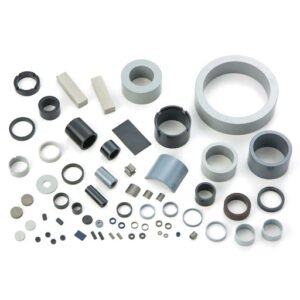
Bonded NdFeB is a composite NdFeB permanent magnet made by uniformly mixing NdFeB powder with a binder such as resin, plastic, or low melting point metal and then using compression extrusion or injection molding methods. The product is formed once, without secondary processing, and can be directly made into various complex shapes. Bonded NdFeB has magnetism in all directions and can be processed into NdFeB compression molds and injection molds. High precision, excellent magnetic properties, good corrosion resistance, and good temperature stability.
(2) Sintered NdFeB Magnet

Sintered neodymium iron boron permanent magnets are smelted after airflow milling. They have a high coercivity and extremely high magnetic properties. Its maximum magnetic energy product (BHmax) is more than 10 times higher than that of ferrite. . Its mechanical properties are also quite good, and it can cut and process different shapes and drill holes. The maximum working temperature of high-performance products can reach 200℃.
Because of its material content, it is easy to cause rust, so the surface must be treated with different coatings according to different requirements. (Such as zinc plating, nickel, environmental zinc, environmental nickel, copper-nickel, copper-nickel, etc.). Very hard and brittle, with high resistance to demagnetization, high cost/performance ratio, not suitable for high working temperature (>200℃).
(3) Injection molded neodymium iron boron (Zhusu NdFeB)
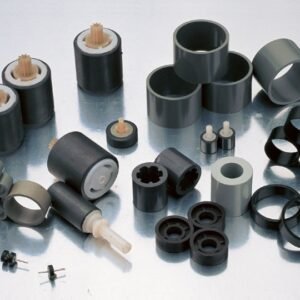 It has extremely high accuracy and is easy to make thin-walled rings or thin magnets with complex anisotropic shapes.
It has extremely high accuracy and is easy to make thin-walled rings or thin magnets with complex anisotropic shapes.
Sintered Ferrite
The main raw materials of sintered ferrite include BaFe12019 and SrFe12019, which are divided into isotropic and anisotropic magnets according to the orientation of the magnetic crystals.
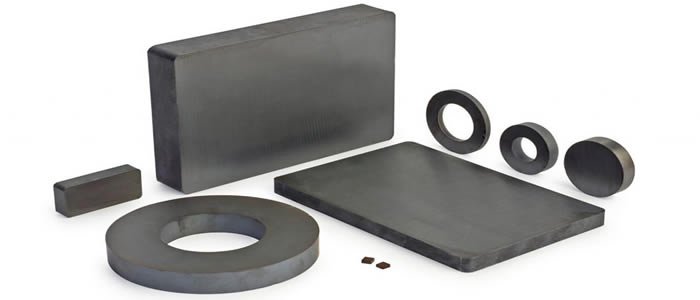
Because of its low price and moderate magnetic properties, it has become a widely used magnet at present. Ferrite magnets are manufactured by ceramic technology, and the texture is relatively hard, and it is also a brittle material. Because of their good temperature resistance and low price, ferrite magnets have become more widely used permanent magnets.
Rubber Magnet
Rubber Magnet (Rubber Magnet) is a kind of ferrite magnetic material series. It is made of bonded ferrite powder and synthetic rubber through extrusion molding, calendering, injection molding, and other processes. It has flexibility, is Flexible, and a twistable magnet. It can be processed into strips, rolls, flakes, and various complex shapes. Rubber magnets are made of magnetic powder (SrO6Fe2O3), polyethylene (CPE), and other additives (EBSO, DOP), etc., and are manufactured by extrusion and calendering.

The rubber magnetic material can be of the same sex or the opposite sex. It is made of ferrite magnetic powder, CPE, and some trace elements and can be bent, twisted, and rolled. It can be used without more mechanical processing, and the shape can be trimmed according to the required size. According to customer requirements, the rubber magnet can also be compounded with PVC, back glue, UV oil, etc. Its magnetic energy product is between 0.60 and 1.50 MGOe. Application areas of rubber magnetic materials: refrigerators, information signage racks, fasteners for fixing objects to metal bodies for advertisements, etc., magnetic sheets for toys, teaching instruments, switches, and sensors. Mainly used in micro-motors, refrigerators, disinfection cabinets, kitchen cabinets, toys, stationery, advertising, and other industries.
AlNiCo
Aluminium Nickel Cobalt (AlNiCo) is the first permanent magnet material developed. It is an alloy composed of aluminium, nickel, cobalt, iron, and other trace metal elements. Different production processes divide it into sintered aluminium nickel cobalt (Sintered AlNiCo) and cast aluminium nickel cobalt (Cast AlNiCo).

Alnico permanent magnet products are widely used in various instruments and other applications. The product shapes are mostly round and square. The casting process can be processed into different sizes and shapes; compared with the casting process, sintered products are limited to small sizes, and the produced blanks have better dimensional tolerances than cast products, and their magnetic properties are slightly lower than that of cast products, but they can Workability is better. Cast AlNiCo permanent magnets have the lowest reversible temperature coefficient among the permanent magnet materials, and the working temperature can be as high as 600℃.
Samarium Cobalt
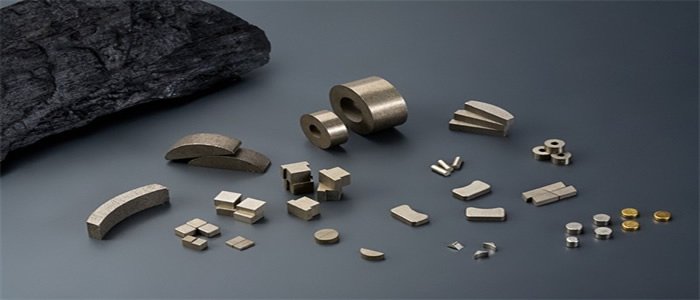
The samarium cobalt (SmCo) composition is divided into SmCo5 and Sm2Co17, the first and second-generation rare earth permanent magnet materials. Because its raw materials are very scarce and expensive, its development is restricted. Samarium cobalt (SmCo), as the second-generation rare earth permanent magnet, not only has a high magnetic energy product (14-28MGOe) and reliable coercivity and exhibits good temperature characteristics in the rare earth permanent magnet series. Compared with NdFeB, samarium cobalt is more suitable for working in a high-temperature environment (>200℃).
Permanent magnets are widely used in various fields such as electronics, electrical, machinery, transportation, medical and daily necessities. Such as the permanent magnet of the speaker and telephone receiver; the magnetic system of the magnetoelectric meter; the magnetic pole of the generator and the permanent magnet motor; the permanent magnet device used in the machine manufacturing industry (such as the permanent magnet chuck of the surface grinder, etc.), the magnetic suspension system, and the magnetic bearing; Magnetic separation system, magnetic separation system, magnetic purification water system, magnetron, the magnetic system of a proton accelerator, etc.

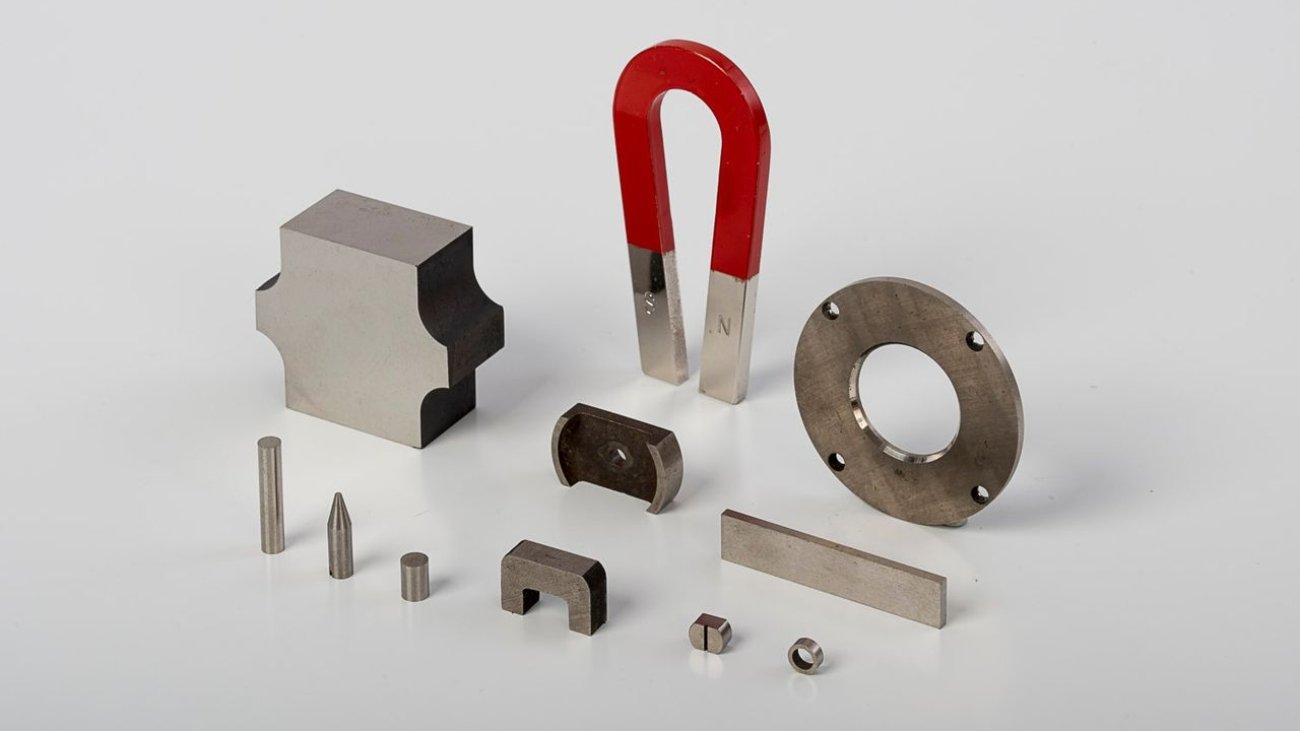

Leave A Comment